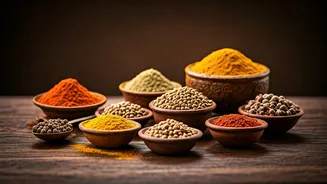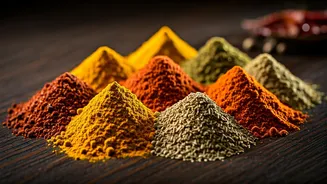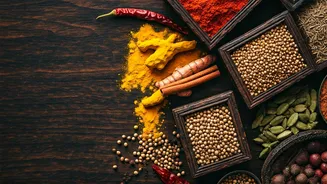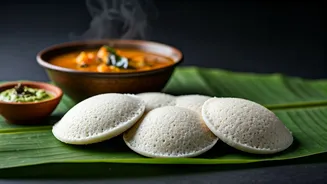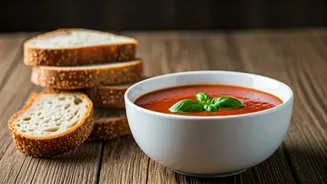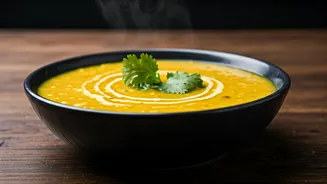Spice Rack Essentials
The foundation of Indian cuisine rests upon a well-stocked spice rack. Key spices form the bedrock of flavour. Turmeric, with its vibrant color and earthy
taste, offers both culinary and health benefits. Cumin, both ground and whole, lends a warm, earthy undertone. Coriander, often used in ground form, delivers a citrusy freshness that brightens any dish. Garam masala, a blend of roasted spices, adds aromatic complexity. Chili powder, used in varying degrees depending on the desired heat level, provides a fiery kick. Other essential spices include ginger, garlic, cardamom, cloves, and cinnamon. Experimenting with these spices allows cooks to create a symphony of flavors and tailor dishes to their preferences. The careful use of these spices is what gives Indian food its distinct character.
Mastering Cooking Methods
Several fundamental cooking methods distinguish Indian cuisine. Tadka, a technique of tempering spices in hot oil, releases their flavors, which infuses the entire dish. Frying, both deep and shallow, is commonly used to create crispy textures. Sautéing is another prevalent technique, where ingredients are cooked gently in oil until softened and slightly browned. Grilling, whether on a tandoor (clay oven) or a conventional grill, imparts a smoky char. Stewing, a slow cooking method, allows flavors to meld, creating rich and complex dishes. Braising, a combination of browning and simmering, also delivers deep, savory tastes. Knowing these methods is critical for recreating authentic Indian flavors. The control over heat and the timing are essential to making a successful dish. These methods combined with a good understanding of spice usage make for a memorable culinary experience.
Classic Curry Creations
Curry, in its myriad forms, is the heart of Indian cuisine. Butter chicken, a creamy tomato-based dish with tender chicken pieces, stands as a crowd-pleaser. Chicken tikka masala, often cited as a British-Indian creation, consists of grilled chicken in a spiced tomato-cream sauce. Saag paneer, a spinach-based curry with Indian cheese, is a beloved vegetarian option. Rogan josh, a fragrant lamb curry from Kashmir, is characterized by its deep red color and complex flavors. Vindaloo, a spicy pork dish originating from Goa, showcases the influence of Portuguese cuisine. Each curry varies significantly based on regional preferences and family recipes, highlighting India's diverse culinary heritage. From the creamy to the fiery, these curries are just a starting point for culinary exploration.
Regional Delights Explored
India's regions offer a tapestry of culinary treasures. In North India, you find rich gravies, tandoori preparations, and bread like naan and roti. The South is characterized by rice-based dishes, coconut milk, and dishes like idli, dosa, and sambar. West India brings forth the flavors of Maharashtra and Gujarat, known for their vegetarian thalis and seafood preparations. East India features the use of mustard oil, fish curries, and sweets. Each state and region boasts its unique blend of spices and cooking methods. For example, Bengal has fish-based dishes, while Kerala has seafood and coconut milk. Every region has an array of ingredients and flavours for you to try.
Rice and Bread Essentials
Rice and bread form the foundation of many Indian meals. Basmati rice, with its long grains and fragrant aroma, is a staple. Various types of rice, such as jeera rice (cumin-infused rice) and pulao (rice pilaf), are common accompaniments. Naan, a leavened flatbread baked in a tandoor oven, is a classic pairing for curries. Roti, an unleavened flatbread, is made from whole wheat flour and cooked on a griddle. Paratha, layered flatbread often stuffed with vegetables or spices, offers a richer texture. Puri, deep-fried puffed bread, is a delightful addition to breakfasts and special occasions. Understanding the variety of rice and bread allows for balanced and diverse meal experiences. These foods complement the curries and other main courses.
Sweet Endings: Desserts
Indian desserts offer a rich variety of flavors and textures. Gulab jamun, deep-fried milk balls soaked in a sugar syrup, is a popular treat. Rasgulla, spongy cheese balls dipped in syrup, is another beloved dessert. Jalebi, a deep-fried pretzel-shaped sweet soaked in syrup, offers a satisfying crunch. Kulfi, an Indian ice cream made from condensed milk, is available in various flavors. Halwa, a sweet pudding made from various ingredients, like semolina, carrots, or lentils, is frequently served at celebrations. These desserts often incorporate nuts, spices, and dried fruits, adding complexity and depth of flavor. Their sweetness balances the spices in savory dishes, completing a fulfilling dining experience.
